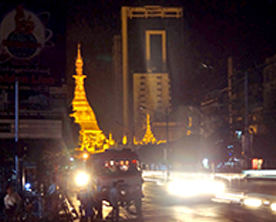A nation fed up with blackouts will be keeping an eye on how the NLD government tackles the power outages in the coming months.
Myanmar’s new NLD-led government issued a ‘First 100-day Plan’ shortly after coming to power in March. This initiative was an effort to address and prioritize reforms citizens could expect to see from the new administration’s first three months in power. Among the most anticipated reforms in the initiative was the promise for a more reliable energy supply. Now near the end of the first 100 days, it appears the government has made some strides in improving the energy sector but still has a long way to go in order to make Myanmar blackout free.
Energy Reforms Promised by the Government
In a state-owned newspaper interview concerned with the ‘100-Day Plan’, Union Minister Pe Zin Tun said there will be construction works for new electricity transmission lines and electrical substations in regions and states during the 100 days. The ministry plans to implement new power stations and the officials are also hoping to mitigate the current losses in power distribution. In respect to power transmission, a 230 KV transmission line, a 66 KV transmission line, new electrical substations are currently being constructed as fast as possible.
With regard to electric power generation, he said that the waste heat recovery power unit of the natural gas power station in Mawlamyine was ready to produce 30 megawatts starting from mid-May and the natural gas power generator located in Myingyan district was set to produce 133 megawatts starting from late May.
According to the interview, there are electricity transmission and distribution projects in which power transmission lines and electrical substations are constantly built in Naypyidaw, Kachin State, Kayah State, Sagaing Region, Magway Region and Ayeyarwady Region.
Difficulties Ahead and Inadequate Infrastructure
The Union Minister said it may be difficult to accomplish all the planned activities, including ongoing projects and construction works, in the timeframe of 100 days. Still, they are trying to finish the existing construction works of some power stations as soon as possible.
The authorities are set to undertake upgrading of the power infrastructure which will include various works that would enhance the availability of electricity under the 100-Day Plan, according to the Chief Minister. However, Yangon Region Chief Minister Phyo Min Thein justified the recent growing number of power shortages in Yangon, stating they were caused by rising temperatures and heavy rain that have damaged underground power cables and cable towers.
Myanmar has historically struggled with power insufficiency, due to both technical and financial deprivation. When the NLD-led government came to power this past dry-season, public expectation soared for rapid changes in the energy sector. However, blackouts have only appeared to become more frequent in recent months. Myanmar continues to be among the least powered countries in Southeast Asia with just 30 percent of the population have access to electricity – and, those with access, never know when a blackout might occur, causing stress not only in average households but for businesses as well.
As frustration with blackouts persist for the average citizen, it is apparent that the fledgling government still has a lot of reform promises to meet.










